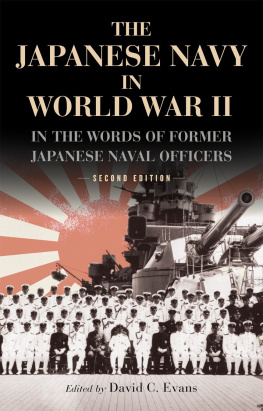Yoshida Mitsuru - Requiem for Battleship Yamato
Here you can read online Yoshida Mitsuru - Requiem for Battleship Yamato full text of the book (entire story) in english for free. Download pdf and epub, get meaning, cover and reviews about this ebook. year: 2013, publisher: Naval Institute Press, genre: Romance novel. Description of the work, (preface) as well as reviews are available. Best literature library LitArk.com created for fans of good reading and offers a wide selection of genres:
Romance novel
Science fiction
Adventure
Detective
Science
History
Home and family
Prose
Art
Politics
Computer
Non-fiction
Religion
Business
Children
Humor
Choose a favorite category and find really read worthwhile books. Enjoy immersion in the world of imagination, feel the emotions of the characters or learn something new for yourself, make an fascinating discovery.

- Book:Requiem for Battleship Yamato
- Author:
- Publisher:Naval Institute Press
- Genre:
- Year:2013
- Rating:4 / 5
- Favourites:Add to favourites
- Your mark:
- 80
- 1
- 2
- 3
- 4
- 5
Requiem for Battleship Yamato: summary, description and annotation
We offer to read an annotation, description, summary or preface (depends on what the author of the book "Requiem for Battleship Yamato" wrote himself). If you haven't found the necessary information about the book — write in the comments, we will try to find it.
A young ensign on the bridge of the fabled battleship Yamato during her final battle, recounts his experience.
Requiem for Battleship Yamato — read online for free the complete book (whole text) full work
Below is the text of the book, divided by pages. System saving the place of the last page read, allows you to conveniently read the book "Requiem for Battleship Yamato" online for free, without having to search again every time where you left off. Put a bookmark, and you can go to the page where you finished reading at any time.
Font size:
Interval:
Bookmark:
Requiem for Battleship Yamato

The latest edition of this work has been brought to publication with the generous assistance of Marguerite and Gerry Lenfest.
1985 by the University of Washington Press
All rights reserved. No part of this book may be reproduced or utilized in any form or by any means, electronic or mechanical, including photocopying and recording, or by any information storage and retrieval system, without permission in writing from the publisher.
Originally published by the University of Washington Press with the assistance of a grant from the Japan Foundation.
First Bluejacket Books printing, 1999
ISBN 978-1-61251-208-2 (eBook)
The Library of Congress has cataloged the paperback edition as follows:
Yoshida, Mitsuru
[Senkan Yamato no saigo. English]
Requiem for Battleship Yamato / Yoshida Mitsuru ; translation and introduction by Richard H. Minear.
p. cm.
1. Yamato (Battleship) 2. World War, 19391945Naval Operation, Japanese. 3. World War, 19391945Personal narratives, Japanese. 4. Yoshida, Mitsuru. I. Minear, Richard H. II. Title.
D777.5.Y33Y6713 1999
940.545952dc21
98-54794
 Print editions meet the requirements of ANSI/NISO z39.48-1992 (Permanence of Paper).
Print editions meet the requirements of ANSI/NISO z39.48-1992 (Permanence of Paper).
10 9 8 7 6 5
To the memory of Takashima Eiko,
tutor at her home in Kyoto to generations of foreigners,
my principal tutor for three years; and
to the other native speakers who instructed me in Japanese,
whether in Japan or in America, most notably
Teruko Craig, Inoki Takenori, Itasaka Gen,
Matsuki Miyako, Miyo Okada, Schind Eiichi,
and Takami Toshihiro.
Contents
This is my first major translation project, and my debts are many and varied. The first debt is to those mentioned in the dedication, the native speakers who played so important a role in my formal language training. It is now twenty-five years since I began to study Japanese in the summer of 1960; I hope I have another twenty-five years to continue that study. Formal tutoring came to an end in 1971; but friends and colleagues have been most generous with their time and knowledge in continuing the process.
Libraries and librarians played their role. Frank Joseph Shulman, Director of the East Asia Collection of McKeldin Library at the University of Maryland, forwarded to me copies of the Gordon W. Prange Collections file on Requiem and permitted me to quote from it. D. C. Allard of the Operational Archives Branch of the Naval Historical Center in Washington, D.C., Mitsuko Ichinose of the East Asian Collection at Yale University, and William T. Murphy of National Archives all responded promptly to inquiries.
As always, I have leaned on colleagues at the University of Massachusetts. Ching-mao Cheng and William Naff helped me with problems of translation. Hugh Bell showed endless patience with my queries about nautical terms and expressions. Tadanori Yamashita of Mount Holyoke College, a Five College colleague, spent long hours going over an initial draft.
Among many who read the manuscript in one or more of its incarnations and offered comments and encouragement, I can mention only the following: John J. Conway, John W. Dower, G. Barbara and the late Donald Einfurer, Peter Grilli, Mary Lewis, Joyce McDonough, my parents Paul and Gladys Minear, Mark Perry, Roger Pineau, Hajime Sakai, Robert N. Smith, Frederick W. Steinbeck, Henry I. Tragle, the late Robert G. Tucker, H. Leland Varley, the late R. G. Vliet.
Hiroaki Sato, initially a reader for University of Washington Press, was kind enough thereafter to give the entire manuscript a close reading. He also forwarded it to Charles Deroko and George Matteson for their comments. I am greatly in their debt.
Yoshida Yoshiko, widow of the author, showed a deep interest from the first. After several years correspondence, we met for the first time in Tokyo in June 1983. Her warm support I acknowledge gratefully. Thanks to Mrs. Yoshida, I received assistance as well from Azuma Mafumi, Hara Katsuhiro, Nakai Haruo, and Tsukasa Tadayuki. Captain Baba Toshihaya (Maritime Self Defense Force), commanding officer of Air Station Atsugi, went through the entire manuscript with great care; the final translation is much sounder thanks to his efforts.
Et Jun first brought this memoir to my attention. As the Translators Introduction indicates, I do not see eye to eye with Et; but I do thank him for his encouragement and assistance. Sodei Rinjir took an early interest in this project and sent me useful material.
Most helpful of all was Yasuko Fukumi, librarian for East Asian Studies at the University of Massachusetts here in Amherst. She located materials for me in Amherst and in Tokyo; she went over many drafts with a dedicated and accurate eye, spending long hours with me discussing the text; she enlisted the help of family and friends in JapanFukumi Sachiko, Sat Tomoko, and especially Sayama Jir and Sayama Kykoand Amherst in her determination that Yoshidas memoir receive the treatment it deserves; she assisted in my correspondence with people in Japan. I could not have asked for more support; she was always ready to help and always cheerful in helping. I hope this translation lives up to her hopes.
My agent Bonnie Crown was indefatigable in her pursuit of a press; she also commented helpfully on text and layout: At the University of Washington Press, Don Elle-good, Julidta Tarver, and Bruce Wilcox guided the manuscript through; Gretchen Swanzey made a very large number of most useful editorial suggestions; and Audrey Meyer was responsible for developing the books format. I am indebted also to Nobuki Sabur and Stephen Shaw of Kodansha Ltd. for kind treatment and editorial suggestions.
Despite all this help, there are still errors in this translation; they are mine.
Throughout I have rendered names in their Japanese order: family name first, given name second. Yoshida is the authors family name; Mitsuru, his given name. Similarly, I have referred to geographical places by their Japanese names: sumi Strait, for example, rather than Van Diemen Strait.
Requiem for Battleship Yamato is Yoshida Mitsurus story of his own experience as a junior naval officer in April 1945, when Yamato set out on a last and desperate sortie. As with most great battle stories, its ultimate concern is less bombs and bullets than human nature, less death than life. It has long been a minor classic in Japan; this is the first full translation into any other language.
The Battle for Okinawa, AprilJune 1945
Situated 600 kilometers southwest of the island of Kysh, Okinawa was the last stop on the Allied drive to Japanlast, that is, except for the main islands themselves. American forces landed on Okinawa on 1 April 1945. The Japanese responded with counterattacks on land, with aerial suicide attacks by pilots flying from Kysh, and with the final task force sortie of the Imperial Japanese Navy.
Next pageFont size:
Interval:
Bookmark:
Similar books «Requiem for Battleship Yamato»
Look at similar books to Requiem for Battleship Yamato. We have selected literature similar in name and meaning in the hope of providing readers with more options to find new, interesting, not yet read works.
Discussion, reviews of the book Requiem for Battleship Yamato and just readers' own opinions. Leave your comments, write what you think about the work, its meaning or the main characters. Specify what exactly you liked and what you didn't like, and why you think so.








